Imperial Japanese Navy
- For Combined Fleet, please see that article.
| Imperial Japanese Navy (IJN) 大日本帝國海軍 (Dai-Nippon Teikoku Kaigun) | |
|---|---|
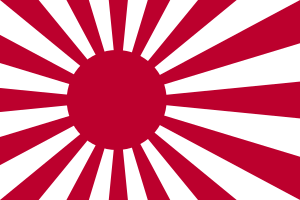 The ensign of the Imperial Japanese Navy and Japan Maritime Self-Defense Force. | |
| Active | 1869-1947 |
| Country | Empire of Japan |
| Allegiance | Empire of Japan |
| Branch | Combined Fleet Imperial Japanese Navy Air Service Imperial Japanese Navy Land Forces |
| Type | Navy |
| Engagements | First Sino-Japanese War Russo-Japanese War World War I World War II |
| Commanders | |
| Notable commanders | Isoroku Yamamoto Togo Heihachiro Hiroyasu Fushimi and many others |
| Insignia | |
| Identification symbol |  Imperial Seal of Japan and Seal of the Imperial Japanese Navy |
The Imperial Japanese Navy (IJN) (Kyūjitai: 大日本帝國海軍 Shinjitai: 大日本帝国海軍 or 日本海軍 Nippon Kaigun), officially Navy of the Empire of Greater Japan, also known as the Japanese Navy was the Navy of the Empire of Japan from 1869 until 1947, when it was dissolved following Japan's constitutional renunciation of the use of force as a means of settling international disputes. It was the third largest navy in the world by 1920 behind the United States Navy and Royal Navy,[1] and perhaps the most modern at the brink of World War II. It was supported by Imperial Japanese Navy Air Service for aircraft and airstrike operation from the fleet.
The origins of the Imperial Japanese Navy trace back to early interactions with nations on the Asian continent, beginning in the early medieval period and reaching a peak of activity during the 16th and 17th centuries at a time of cultural exchange with European powers during the Age of Discovery. After two centuries of stagnation during the country's ensuing seclusion policy under the shoguns of the Edo period, Japan's Navy was comparatively backward when the country was forced open to trade by American intervention in 1854. This eventually led to the Meiji Restoration. Accompanying the re-ascendance of the Emperor came a period of frantic modernization and industrialization. The navy's history of successes, sometimes against much more powerful foes as in the 1895 Sino-Japanese war and the 1905 Russo-Japanese War, ended in almost complete annihilation during the concluding days of World War II. The IJN was officially dissolved in 1945.
Origins
Japan has a long history of naval interaction with the Asian continent, involving transportation of troops between Korea and Japan, starting at least with the beginning of the Kofun period in the 3rd century.
Following the attempts at Mongol invasions of Japan by Kubilai Khan in 1274 and 1281, Japanese "Wakō" pirates became very active in plundering the coast of the Chinese Empire.

Japan undertook major naval building efforts in the 16th century, during the Warring States period, when feudal rulers vying for supremacy built vast coastal navies of several hundred ships. Around that time, Japan may have developed one of the first ironclad warships, when Oda Nobunaga, a Japanese daimyo, had six iron-covered Oatakebune made in 1576.[2] In 1588, Toyotomi Hideyoshi issued a ban on Wakō piracy; the pirates then became vassals of Hideyoshi, and comprised the naval force used in the Japanese invasion of Korea.
Japan built her first large ocean-going warships in the beginning of the 17th century, following contacts with the Western nations during the Nanban trade period. In 1613, the Daimyo of Sendai, in agreement with the Tokugawa Bakufu, built Date Maru, a 500 ton galleon-type ship that transported the Japanese embassy of Hasekura Tsunenaga to the Americas, which then continued to Europe. From 1604, about 350 Red seal ships, usually armed and incorporating some Western technologies, were also commissioned by the Bakufu, mainly for Southeast Asian trade.
Seclusion and Western studies

From 1640 and for more than 200 years, Japan chose the policy of "Sakoku" (seclusion), which forbade contacts with the West, eradicated Christianity, and prohibited the construction of ocean-going ships on pain of death. Contacts were maintained through the Dutch enclave of Dejima however, allowing for the transfer of a vast amount of knowledge related to the Western technological and scientific revolution. This study of Western sciences, called "Rangaku", also allowed Japan to remain updated in areas relevant to naval sciences, such as cartography, optics or mechanical sciences. The full study of Western shipbuilding techniques resumed in the 1840s during the Late Tokugawa shogunate ("Bakumatsu").
Early modernization of the Shogunal Navy
In 1853 and 1854, U.S. Navy Commodore Matthew Perry made a demonstration of force with the newest steam warships of the U.S. Navy. Perry finally obtained the opening of the country to international trade through the 1854 Convention of Kanagawa. This was soon followed by the 1858 "unequal" U.S.-Japan Treaty of Amity and Commerce, which allowed the establishment of foreign concessions, extra-territoriality for foreigners, and minimal import taxes for foreign goods.
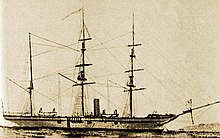
As soon as Japan agreed to open up to foreign influence, the Tokugawa shogun government initiated an active policy of assimilation of Western naval technologies. In 1855, with Dutch assistance, the Shogunate acquired its first steam warship, Kankō Maru, which was used for training, and established the Nagasaki Naval Training Center. In 1857, it acquired its first screw-driven steam warship, the Kanrin Maru. In 1859, the Naval Training Center was transferred to Tsukiji in Tokyo. Naval students were sent to study in Western naval schools for several years, such as the future Admiral Takeaki Enomoto (who studied in the Netherlands from 1862–1867), starting a tradition of foreign-educated future leaders such as Admirals Heihachiro Togo and, later, Isoroku Yamamoto.

As early as 1863, less than 10 years after openning the country to foreign interaction, Japan completed its first domestically-built steam warship, the 1863 Chiyodagata. In 1865, the French naval engineer Léonce Verny was hired to build Japan's first modern naval arsenals, at Yokosuka and Nagasaki. In 1867-1868, a British Naval mission was sent to Japan to assist the development of the Navy.[3]

By the end of the Tokugawa shogunate in 1867, the Tokugawa navy was already the largest of Eastern Asia, organized around eight Western-style steam warships and the flagship Kaiyō Maru, which were used against pro-imperial forces during the Boshin War, under the command of Admiral Enomoto. The conflict culminated with the Naval Battle of Hakodate in 1869, Japan's first large-scale modern naval battle, and ended with the defeat of the last Tokugawa forces and the restoration of Imperial rule. The revolutionary French-built ironclad Kotetsu, originally ordered by the Tokugawa shogunate, was receptioned by the Imperial side and was used decisively towards the end of the conflict.
Creation of the Imperial Japanese Navy (1869)

From 1868, the restored Meiji Emperor continued with reforms to industrialize and militarize Japan to prevent the United States and European powers from overwhelming her. On 17 January 1868, the Ministry of Military Affairs (兵部省, also known as the Army-Navy Ministry) was established, with Iwakura Tomomi, Shimazu Tadayoshi and Prince Komatsu-no-miya Akihito as the First Secretaries.

On 26 March 1868, the first Naval Review was held in Japan (in Osaka Bay), with 6 ships from the private domainal navies of Saga, Chōshū, Satsuma, Kurume, Kumamoto and Hiroshima participating. The total tonnage of these ships was 2252 tons, which was far smaller than the tonnage of the single foreign vessel (from the French Navy) that also participated. The following year, in July 1869, the Imperial Japanese Navy was formally established, two months after the last combat of the Boshin War.
In July 1869, the private domanial navies were abolished, and their 11 ships were added to the 7 surviving vessels of the defunct Tokugawa bakufu navy to form the core of the new Imperial Japanese Navy. In February 1872, the Ministry of Military Affairs was replaced by a separate Army Ministry (陸軍省) and Navy Ministry (海軍省). In October 1873, Katsu Kaishu became Navy Minister. The new government drafted an ambitious plan to create a Navy with 200 ships organized into 10 fleets. It was abandoned within a year due to lack of resources.
British support

During the 1870s and 1880s, the Imperial Japanese Navy remained an essentially coastal defense force, although the Meiji government continued to modernize it. Jho Sho Maru (soon renamed Ryūjō Maru) commissioned by Thomas Glover was launched at Aberdeen, Scotland on March 27, 1869. In 1870, an Imperial decree determined that Britain's Royal Navy should be the model for development, instead of the Netherlands.[4]
From September 1870, the English Lieutenant Horse, a former gunnery instructor for the Saga fief during the Bakumatsu period, was put in charge of gunnery practice onboard the Ryūjō.[5] In 1871, the Ministry resolved to send 16 traineed abroad for training in naval sciences (14 to Great Britain, 2 to the United States), among which was Togo Heihachiro.[6] A 34-member British naval mission visited Japan in 1873 for two years, headed by Comdr. Archibald Douglas.[7] Later, Comdr. L.P. Willan was hired in 1879 to train naval cadets.
First interventions abroad (Taiwan 1874, Korea 1875-76)


During 1873, a plan to invade the Korean peninsula (the Seikanron proposal made by Saigo Takamori) was narrowly abandoned by decision of the central government in Tokyo. In 1874, the Taiwan expedition was the first foray abroad of the new Imperial Japanese Navy and the Imperial Japanese Army.
Various interventions in the Korean peninsula continued in 1875-1876, starting with the Ganghwa Island incident (江華島事件) provoked by the Japanese gunboat Unyo, leading to the dispatch of a large force of the Imperial Japanese Navy. As a result, the Treaty of Ganghwa was signed, marking the official opening of Korea to foreign trade, and Japan's first example of Western-style interventionism and adoption of Unequal treaties tactics.
Soon however domestic rebellions, the Saga Rebellion (1874) and especially the Satsuma Rebellion (1877), forced the government to focus on land warfare. Naval policy, expressed by the slogan Shusei Kokubō (Jp:守勢国防, lit. "Static Defense"), focused on coastal defenses and a standing army (established with the assistance of the second French Military Mission to Japan), and a coastal Navy, leading to a military organization under the Rikushu Kaijū (Jp:陸主海従, Army first, Navy second) principle.
Further modernization (1870s)
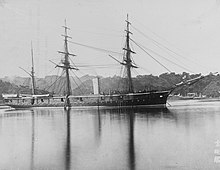
Ships such as the Fusō, Kongō (1877) and the Hiei (1877) were built in British shipyards specifically for the Imperial Japanese Navy. Private construction companies such as Ishikawajima and Kawasaki also emerged around this time.
In 1883 two large warships were ordered from British shipyards. Naniwa and the Takachiho were 3,650-ton ships. They were capable of speeds up to 18 knots (33 km/h) and were armed with 2 to 3-inch deck armor and two 10.2-in (260 mm) Krupp guns. The naval architect Sasō Sachū designed these on the line of the Elswick class of protected cruisers but with superior specifications. An arms race was taking place with China however, who equipped herself with two German-built battleships of 7,335 tons (Ting Yüan and Chen-Yüan). Unable to confront the Chinese fleet with only two modern cruisers, Japan resorted to French assistance to build a large, modern fleet which could prevail in the upcoming conflict.
Influence of the French "Jeune Ecole" (1880s)

During the 1880s, France took the lead in influence, due to its "Jeune Ecole" ("young school") doctrine favoring small, fast warships, especially cruisers and torpedo boats, against bigger units. The choice of France may also have been influenced by the Minister of the Japanese Navy ((海軍卿), who happened to be Enomoto Takeaki at that time (Navy Minister 1880-1885), a former ally of the French during the Boshin War.
The Meiji government issued its First Naval Expansion bill in 1882, requiring the construction of 48 warships, of which 22 were to be torpedo boats. The naval successes of the French Navy against China in the Sino-French War of 1883-85 seemed to validate the potential of torpedo boats, an approach which was also attractive to the limited resources of Japan. In 1885, the new Navy slogan became Kaikoku Nippon (Jp:海国日本, lit. "Maritime Japan").
In 1885, the leading French Navy engineer Emile Bertin was hired for four years to reinforce the Japanese Navy and to direct the construction of the arsenals of Kure and Sasebo. He developed the Sanseikan class of cruisers; 3 units featuring a single powerful main gun, the 12.6in (320mm) Canet gun. Altogether, Bertin supervised the building of more than twenty units. They helped establish the first true modern naval force of Japan. It allowed Japan to achieve mastery in the building of large units, since some of the ships were imported, and some others were built domestically at the arsenal of Yokosuka:
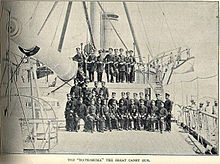
- 3 cruisers: the 4,700 ton Matsushima and Itsukushima, built in France, and the Hashidate, built at Yokosuka.
- 3 coastal warships of 4,278 tons.
- 2 small cruisers: the Chiyoda, a small cruiser of 2,439 tons built in Britain, and the Yaeyama, 1800 tons, built at Yokosuka.
- 1 frigate, the 1600 ton Takao, built at Yokosuka.
- 1 destroyer: the 726 ton Chishima, built in France.
- 16 torpedo boats of 54 tons each, built in France by the Companie du Creusot in 1888, and assembled in Japan.
This period also allowed Japan "to embrace the revolutionary new technologies embodied in torpedoes, torpedo-boats and mines, of which the French at the time were probably the world's best exponents"[8]. Japan acquired its first torpedoes in 1884, and established a "Torpedo Training Center" at Yokosuka in 1886.
These ships, ordered during the fiscal years 1885 and 1886, were the last major orders placed with France. The unexplained sinking of the Unebi in route from France to Japan in December 1886, created diplomatic frictions and doubts about the French designs.
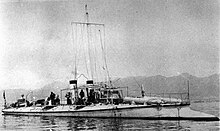
Japan turned again to Britain, with the order of a revolutionary torpedo boat, the 1887 Kotaka, which is considered the first ever effective design of a destroyer[9], and with the purchase of the Yoshino, built at the Armstrong works in Elswick, Newcastle upon Tyne, the fastest cruiser in the world at the time of her launch in 1892.[10]
Sino-Japanese War (1894-1895)


Japan continued the modernization of its navy, especially as China was also building a powerful modern fleet with foreign, especially German, assistance, and the pressure was building between the two countries to take control of Korea. The Sino-Japanese war was officially declared on August 1, 1894, though some naval fighting had already taken place.
The Japanese navy devastated Qing's Beiyang Fleet off the mouth of the Yalu River at the Battle of Yalu River on September 17 1894, in which the Chinese fleet lost 8 out of 12 warships. Although Japan turned out victorious, the two large German-made battleships of the Chinese Navy remained almost impervious to Japanese guns, highlighting the need for bigger capital ships in the Japanese Navy (Ting Yuan was finally sunk by torpedoes, and Chen-Yuan was captured with little damage). The next step of the Imperial Japanese Navy's expansion would thus involve a combination of heavily armed large warships, with smaller and innovative offensive units permitting aggressive tactics.
As a result of the conflict, under the Treaty of Shimonoseki (April 17th, 1895), Taiwan and the Pescadores Islands were transferred to Japan. The Imperial Japanese Navy took possession of the island and quelled opposition movements between March to October 1895, and the islands continued to be a Japanese colony until 1945. Japan also obtained the Liaodong Peninsula, although she was forced by Russia to return it to China, only to see Russia take possession of it soon after.
Suppression of the Boxer rebellion (1900)

The Imperial Japanese Navy further intervened in China in 1900, by participating together with Western Powers to the suppression of the Chinese Boxer Rebellion. The Navy supplied the largest number of warships (18, out of a total of 50 warships), and delivered the largest contingent of Army and Navy troops among the intervening nations (20,840 soldiers, out of total of 54,000).
The conflict allowed Japan to combat together with Western nations, and to acquire first hand understanding of their fighting methods.
Russo-Japanese War (1904-1905)

Following the Sino-Japanese War, and the humiliation of the forced return of the Liaotung peninsula to China under Russian pressure (the "Triple Intervention"), Japan began to build up its military strength in preparation for further confrontations. Japan promulgated a ten-year naval build-up program, under the slogan "Perseverance and determination" (Jp:臥薪嘗胆, Gashinshōtan), in which it commissioned 109 warships, for a total of 200,000 tons, and increased its Navy personnel from 15,100 to 40,800. The new fleet consisted of:
- 6 battleships (all British-made)
- 8 armored cruisers (4 British, 2 Italian, 1 German, and 1 French-made)
- 9 cruisers (5 Japanese, 2 British and 2 US-made)
- 24 destroyers (16 British and 8 Japanese-made)
- 63 torpedo boats (26 German, 10 British, 17 French, and 10 Japanese-made)
One of these battleships, Mikasa, the most advanced ship of her time,[12] was ordered from the Vickers shipyard in the United Kingdom at the end of 1898, for delivery to Japan in 1902. Commercial shipbuilding in Japan was exhibited by construction of the twin screw steamer Aki-Maru, built for Nippon Yusen Kaisha by the Mitsubishi Dockyard & Engine Works, Nagasaki. The Imperial Japanese cruiser Chitose was built at the Union Iron Works in San Francisco, California.
These dispositions culminated with the Russo-Japanese War (1904–1905). At the Battle of Tsushima, Admiral Togo onboard Mikasa led the combined Japanese fleet into what has been called "the most decisive naval battle in history".[13] The Russian fleet was almost completely annihilated: out of 38 Russian ships, 21 were sunk, 7 captured, 6 disarmed, 4,545 Russian servicemen died and 6,106 were taken prisoner. On the other hand, the Japanese only lost 116 men and 3 torpedo boats. These victories broke Russian strength in East Asia, and triggered waves of mutinies in the Russian Navy at Sevastopol, Vladivostok and Kronstadt, peaking in June with the Battleship Potemkin uprising, thereby contributing to the Russian Revolution of 1905.

During the Russo-Japanese war, Japan also made frantic efforts to have a fleet of submarines. Submarines had only recently become operational military engines, and were considered to be special weapons of considerable potential. The Imperial Japanese Navy acquired its first submarines in 1905 from the United States Electric Boat Company, barely four years after the U.S. Navy had commissioned its own first submarine, USS Holland. The ships were Holland designs. They were shipped in kit to Japan and then assembled at the Yokosuka Naval Yard, to become hulls No1 through 5, and became operational at the end of 1905.
Towards an autonomous national Navy
Japan continued in its efforts to build up a strong national naval industry. Following a strategy of "Copy, improve, innovate",[14] foreign ships of various designs were usually analysed in depth, their specifications often improved on, and then were purchased in pairs so as to organize comparative testing and improvements. Over the years, the importation of whole classes of ships was progressively substituted by local assembly, and then complete local production, starting with the smallest ships, such as torpedo boats and cruisers in the 1880s, to finish with whole battleships in the early 1900s. The last major purchase was in 1913 when the battlecruiser Kongō was purchased from the Vickers shipyard. By 1918, there was no aspect of shipbuilding technology where Japanese capabilities fell significantly below world standards.[15] By 1920, the Imperial Japanese Navy was the world's third largest navy, and was a leader in many aspects of naval development:
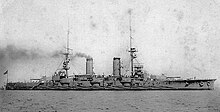
- The Japanese Navy was the first navy in the world to use wireless telegraphy in combat (following its 1897 invention by Marconi), at the 1905 Battle of Tsushima.[16]
- In 1906, it launched the battleship Satsuma, at the time the largest warship in the world by displacement, and the first ship in the world to be designed, ordered and laid down as an "all-big-gun" battleship, about one year before the British HMS Dreadnought.[17]
- Between 1905 and 1910, Japan started to build battleships domestically. The 1906 battleship Satsuma was built in Japan with about 80% parts from Britain, but the next battleship class, the 1910 Kawachi was built with only 20% imported parts.
World War I
Japan entered World War I on the side of the Allies, against Germany and Austria, as a natural prolongation of the 1902 Anglo-Japanese Alliance. After the Battle of Tsingtao, an Anglo-Japanese siege, the Japanese Navy seized the German naval base of Tsingtao on the Shantung peninsula in China, in November 1914. Concurrently a battle group was sent to the central Pacific in August and September to pursue the German East Asiatic squadron, which then moved into the Southern Atlantic, where it encountered British naval forces and was destroyed at the Battle of the Falkland Islands. Japan seized the former possessions of Germany in Micronesia on this occasion (the Mariana Islands (excluding Guam), Caroline Islands and Marshall Islands), which remained Japanese colonies until the end of World War II, under the League of Nations' South Pacific Mandate.
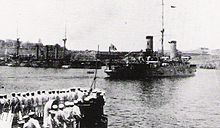
Hard pressed in Europe, where it had only a narrow margin of superiority against Germany, Britain had requested, but was denied, the loan of Japan's four newest Kongō-class battleships (Kongō, Hiei, Haruna, Kirishima), the first ships in the world to be equipped with 14-inch (356 mm) guns, and the most advanced capital ships in the world at the time of their launch.[18]
Following further request to contribute to the conflict, and the advent of unrestricted German submarine warfare from 1917, the Imperial Japanese Navy sent a special force of destroyers to the Mediterranean in March 1917. The fleet, consisting of one armoured cruiser, Nisshin, and eight of the Navy's newest destroyers under Admiral Satō Kōzō, was based in Malta and efficiently protected allied shipping between Marseilles, Taranto and ports in Egypt until the end of the War. One destroyer, Sakaki, was torpedoed by an Austrian submarine with the loss of 59 officers and men.
After the conflict, the Japanese Navy received seven German submarines as spoils of war, which were brought to Japan and analysed, contributing greatly to the development of the Japanese submarine industry.[19]
Interwar years
In the years before WWII the IJN began to structure itself specifically to fight the United States. A long stretch of militaristic expansion and the start of the Second Sino-Japanese war in 1937 had alienated the United States, and the country was seen as a rival of Japan.

The Imperial Japanese Navy was faced, before and during World War II, with considerable challenges, probably more so than any other navy in the world.[20] Japan, like Britain, was almost entirely dependent on foreign resources to supply its economy. To achieve Japan’s expansionist policies, IJN had to secure and protect distant sources of raw material (especially Southeast Asian oil and raw materials), controlled by foreign countries (Britain, the United States and the Netherlands). To achieve this goal, she had to build large warships capable of long range.
This was in conflict with Japan's doctrine of "decisive battle" (a doctrine that did not require long range),[21] in which IJN would allow the U.S. to sail across the Pacific, using submarines to weaken it, then force a battle against the U.S. in a "decisive battle area", near Japan, after inflicting such attrition.[22] This is in keeping with the theory of Alfred T. Mahan, a doctrine to which every major navy subscribed before World War Two, in which wars would be decided by engagements between opposing surface fleets[23] (as they had been for over 300 years). It was the basis for Japan's demand for a 70% ratio (10:10:7) at the Washington Naval Conference, which would give Japan superiority in the "decisive battle area", and the U.S.'s insistence on a 60% ratio, which meant parity.[24] Japan, unlike other navies, clung to it even after it had been demonstrated to be obsolete.
It was also in conflict with her past experience. Japan's numerical and industrial inferiority led her to seek technical superiority (fewer, but faster, more powerful ships), qualitative superiority (better training), and aggressive tactics (daring and speedy attacks overwhelming the enemy, a recipe for success in her previous conflicts). She failed to take account of the fact her opponents in the Pacific War did not face the political and geograpical constraints of her previous wars, nor did she allow for losses in ships and crews.[25]
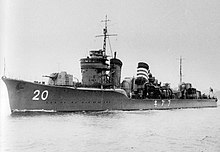
During the interwar, Japan therefore took the lead in many areas of warship development:
- In 1921 it launched the Hōshō, the first purpose-designed aircraft carrier in the world to be completed, and subsequently developed a fleet of aircraft carriers second to none.
- In keeping with its belief in big-gun action, the Imperial Japanese Navy was the first navy in the World to mount 14-in (356 mm) guns (with the Kongō), 16-in (406 mm) guns (with the Nagato), and the only Navy ever to mount 18.1-in (460 mm) guns (with the Yamato).
- In 1928, it launched the innovative Fubuki-class destroyer, introducing enclosed dual 5-inch turrets capable of anti-aircraft fire. The new destroyer design was soon emulated by other navies.
- Japan developed the the 24-inch (610 mm) oxygen fuelled Type 93 "Long Lance" torpedo, generally recognized as the best torpedo in the world, down to the end of World War II (Westwood, Fighting Ships).
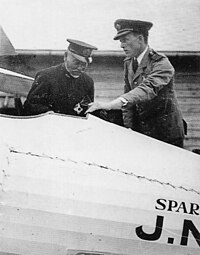
Japan at times continued to solicit foreign expertise in areas in which the IJN was inexperienced in, such as naval aviation. In 1921, Japan hosted for a year and a half the Sempill Mission, a group of British aeronaval instructors who were able to train and advise the Imperial Japanese Navy on several new aircraft such as the Gloster Sparrowhawk and on various techniques such as torpedo bombing and flight control.
During the pre-war years, two schools of thought battled over whether the Navy should be organized around powerful battleships that could ultimately win over American ones in Japanese waters, or around an aggressive fleet of aircraft carriers. Neither really prevailed, and both lines of ships were developed, with the results that neither solution displayed overwhelming strength over the American adversary. A consistent weakness of Japanese warship development was the tendency to incorporate too much armament, and too much engine power, in comparison to ship size (a side-effect of the Washington treaty), leading to shortcomings in stability, protection and structural strength.[26] This was a failing of Japanese naval architects, reflecting her industrial and engineering weakness.
World War II
The Imperial Japanese Navy in World War Two was administered by the Ministry of the Navy of Japan and controlled by the Chief of the Imperial Japanese Navy General Staff at Imperial General Headquarters. In order to combat the numerically superior American navy, the IJN devoted large amounts of resources to creating a force superior in quality to any navy at the time. Consequently, at the beginning of World War II, Japan probably had the most sophisticated Navy in the world.[27] Betting on the speedy success of aggressive tactics (stemming from Mahanian doctrine and the lure of "decisive battle"), Japan did not invest significantly on defensive organization: she needed to protect her long shipping lines against enemy submarines, which she never managed to do, particularly under-investing in the vital role of antisubmarine warfare (both escort ships and escort aircraft carriers), and in the specialized training and organization to support it.[28]"
IJN enjoyed spectacular success during the first part of the hostilities, but American forces ultimately managed to gain the upper hand through technological upgrades to its air and naval forces and a vastly stronger industrial output. Japan's reluctance to use their submarine fleet for commerce raiding and failure to secure their communications also added to their defeat. During the last phase of the war the Imperial Japanese Navy resorted to a series of desperate measures, including a variety of Special Attack Units (popularly called kamikaze).
Battleships
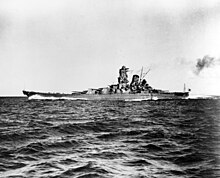
Japan continued to attribute considerable prestige to battleships and endeavoured to build the largest and most powerful ships of the period. Yamato, the largest and most heavily-armed battleship in history, was launched in 1941.
The second half of World War II saw the last battleship duels. In the Battle of Guadalcanal on November 15 1942, the United States battleships South Dakota and Washington fought and destroyed the Japanese battleship Kirishima. In the Battle of Leyte Gulf on 25 October 1944 six battleships, led by Admiral Jesse Oldendorf of the U.S. 7th Fleet fired upon and claimed credit for sinking Admiral Shoji Nishimura's battleships Yamashiro and Fusō during the Battle of Surigao Strait; in fact, both battleships were fatally crippled by destroyer attacks before being brought under fire by Oldendorf's old battleships.
Nevertheless, the Battle off Samar on 25 October 1944 during the Battle of Leyte Gulf showed that battleships could still be useful, albeit inefficient weapons. Only the indecision of Admiral Takeo Kurita and the fight by American destroyers and destroyer escorts saved the American aircraft carriers of "Taffy 3" from being pounded to the bottom by the gunfire of Yamato, Kongō, Haruna, and Nagato and their cruiser escort. Miraculously for the Americans, only USS Gambier Bay, along with two destroyers and one destroyer escort, were lost in this action.
Ultimately, the maturity of air power spelled doom for the battleship. Battleships in the Pacific ended up primarily performing shore bombardment and anti-aircraft defense for the carriers. Yamato and Musashi were sunk by air attacks long before coming in gun range of the American fleet. As a result of the changing technology, plans for even larger battleships, such as the Japanese Super Yamato class, were cancelled.
Aircraft carriers
Japan put particular emphasis on aircraft carriers. The Imperial Japanese Navy started the Pacific War with 10 aircraft carriers, the largest and most modern carrier fleet in the world at that time. There were seven American aircraft carriers at the beginning of the hostilities, only three of them operating in the Pacific; and three British aircraft carriers, of which a single one operated in the Indian Ocean[citation needed]. The IJN's two Shōkaku-class carriers were superior to any carrier in the world, until the wartime appearance of the American Essex-class aircraft carrier.[29] However, a large number of the Japanese carriers were of small size, in accordance to limitations placed upon the Navy by the London and Washington Naval Conferences.
However, following the Battle of Midway, in which four Japanese carriers were sunk, the Japanese Navy suddenly found itself short of fleet carriers, resulting in an ambitious set of projects to convert commercial and military vessels into escort carriers, such as the Hiyō. Another conversion project, Shinano, was based on an incomplete Yamato-class super battleship and became the largest aircraft carrier(In terms of tonnage) of World War II. The IJN also attempted to build a number of fleet carriers, though most of these projects were not completed by the end of the war. One exception being the Taihō, which was the first and only Japanese carrier with a heavy armored flight deck and also the first to incorporate a closed hurricane bow.
Naval aviation

Japan began the war with a highly competent naval air force designed around some of the best airplanes in the world: the Zero was considered the best carrier aircraft of the beginning of the war, the Mitsubishi G3M bomber was remarkable for its range and speed, and the Kawanishi H8K was world's best flying boat.[30] The Japanese pilot corps at the beginning of the war were of high caliber as compared to their contemporaries around the world due to intense training and frontline experience in the Sino-Japanese War.[31] The Navy also had a competent tactical bombing force based around the Mitsubishi G3M and G4M bombers, which astonished the world by being the first planes to sink enemy battleships underway, claiming Prince of Wales and Repulse.
As the war dragged on, the Allies found weaknesses in Japanese Naval Aviation. Though most Japanese aircraft were characterized by great operating ranges, they had very little in the way of defensive armament and armor. As a result, the more numerous, heavily armed and armored American aircraft were able to develop techniques that nullified the advantages of the Japanese aircraft. Although there were delays in engine development, several new competitive designs were developed during the war, but industrial weaknesses, lack of raw materials and disorganization due to Allied bombing raids hampered their mass-production. Furthermore, the IJN didn't have an efficient process for rapid training of aviators, as two years of training were usually considered necessary for a carrier flyer. Therefore, they weren't able to effectively replace seasoned pilots lost through attrition following their initial successes in the Pacific campaign. The IJN pilots' later inexperience was especially evident during the Battle of the Philippine Sea, when their aircraft were shot down in droves by the American naval pilots in what the Americans later called the "Great Marianas Turkey Shoot." Following the Battle of Leyte Gulf, the Japanese Navy increasingly opted towards deploying aircraft in the kamikaze role.

Towards the end of the conflict, several competitive plane designs were developed, such as the 1943 Shiden, but such planes were produced too late and in insufficient numbers (415 units for the Shiden) to affect the outcome of the war. Radical new plane designs were also developed, such as the canard design Shinden, and especially jet-powered aircraft such as the Nakajima Kikka and the rocket-propelled Mitsubishi J8M. These jet designs were partially based on technology received from Nazi Germany, usually in the form of a few drawings only, Kikka being based on the Messerschmitt Me 262 and the J8M on the Messerschmitt Me 163), so Japanese manufacturers had to play a key role in the final engineering. These developments also happened too late in the conflict to have any influence on the outcome. The Kikka only flew once before the end of the war.
Submarines
Japan had by far the most varied fleet of submarines of World War II, including manned torpedoes (Kaiten), midget submarines (Ko-hyoteki, Kairyu), medium-range submarines, purpose-built supply submarines (many for use by the Army), long-range fleet submarines (many of which carried an aircraft), submarines with the highest submerged speeds of the conflict (Senkou I-200), and submarines that could carry multiple bombers (WWII's largest submarine, the Sentoku I-400). These submarines were also equipped with the most advanced torpedo of the conflict, the Type 95 torpedo, a 21" (533mm) version of the famous 24" (61cm) Type 91.
A plane from one such long-range fleet submarine, I-25, conducted what is still the only aerial bombing attack on the continental United States when Warrant Flying Officer Nobuo Fujita attempted to start massive forest fires in the Pacific Northwest outside the town of Brookings, Oregon on September 9th, 1942. Other submarines undertook trans-oceanic missions to German-occupied Europe, such as I-30, I-8, I-34, I-29 and I-52, in one case flying a Japanese seaplane over France in a propaganda coup.[32] In May 1942, Type A midget submarines were used in the Attack on Sydney Harbour, and the Battle of Madagascar.

Overall, despite their technical prowesses, Japanese submarines were relatively unsuccessful. They were often used in offensive roles against warships (per Mahanian doctrine), which were fast, maneuverable and well-defended compared to merchant ships. In 1942, Japanese submarines managed to sink two fleet carriers, one cruiser, and a few destroyers and other warships, and damage several others. They were not able to sustain these results afterwards, as Allied fleets were reinforced and started using better anti-submarine tactics. By the end of the war, submarines were instead often used to transport supplies to island garrisons. During the war, Japan managed to sink about 1 million tons of merchant shipping (184 ships), compared to 1.5 million tons for Britain (493 ships), 4.65 million tons for the US (1079 ships)[citation needed] and 14.3 million tons for Germany (2840 ships).
Early models were not very maneuverable under water, could not dive very deep, and lacked radar. Later in the war, units fitted with radar were in some instances sunk due to the ability of US radar sets to detect their emissions. For example, Batfish (SS-310) sank three such in the span of four days. After the end of the conflict, several of Japan's most original submarines were sent to Hawaii for inspection in "Operation Road's End" (I-400, I-401, I-201 and I-203) before being scuttled by the U.S. Navy in 1946 when the Soviets demanded access to the submarines as well.
Special Attack Units

At the end of the Second World War, numerous Special Attack Units (Japanese: 特別攻撃隊, tokubetsu kōgeki tai, also abbreviated to 特攻隊, tokkōtai) were developed for suicide missions, in a desperate move to compensate for the annihilation of the main fleet. These units included Kamikaze ("Divine Wind") bombers, Shinyo ("Sea Quake") suicide boats, Kairyu ("Sea Dragon") suicide midget submarines, Kaiten ("Turn of Heaven") suicide torpedoes, and Fukuryu ("Crouching Dragon") suicide scuba divers who would swim under boats and use explosives mounted on bamboo poles to destroy both the boat and themselves. Kamikaze planes were particularly effective during the defense of Okinawa, in which 1465 planes were expended to damage around 250 American warships.
A considerable number of Special Attack Units were built and stored in coastal hideouts for the desperate defense of the Home islands, with the potential to destroy or damage thousands of enemy warships.
Self-Defense Forces

Following Japan's surrender to the Allies at the conclusion of World War II, and Japan's subsequent occupation, Japan's entire imperial military was dissolved in the new 1947 constitution which states, "The Japanese people forever renounce war as a sovereign right of the nation and the threat or use of force as a means of settling international disputes." Japan's current navy falls under the umbrella of the Japan Self-Defense Forces (JSDF) as the Japan Maritime Self-Defense Force (JMSDF).
References
- Boxer, C.R. (1993) "The Christian Century in Japan 1549–1650", ISBN 1-85754-035-2
- D'Albas, Andrieu (1965). Death of a Navy: Japanese Naval Action in World War II. Devin-Adair Pub. ISBN 0-8159-5302-X.
- Delorme, Pierre, Les Grandes Batailles de l'Histoire, Port-Arhur 1904, Socomer Editions (French)
- Dull, Paul S. (1978) A Battle History of The Imperial Japanese Navy ISBN 0-85059-295-X
- Evans, David C & Peattie, Mark R. (1997) Kaigun: strategy, tactics, and technology in the Imperial Japanese Navy, 1887–1941 Naval Institute Press, Annapolis, Maryland ISBN 0-87021-192-7
- Gardiner, Robert (editor) (2001) Steam, Steel and Shellfire, The Steam Warship 1815–1905, ISBN 0-7858-1413-2
- Hara, Tameichi (1961). Japanese Destroyer Captain. New York & Toronto: Ballantine Books. ISBN 0-345-27894-1.
{{cite book}}: Cite has empty unknown parameter:|coauthors=(help) - Howe, Christopher (1996) The origins of Japanese Trade Supremacy, Development and technology in Asia from 1540 to the Pacific War, The University of Chicago Press ISBN 0-226-35485-7
- Ireland, Bernard (1996) Jane's Battleships of the 20th Century ISBN 0-00-470997-7
- Lacroix, Eric (1997). Japanese Cruisers of the Pacific War. Naval Institute Press. ISBN 0-87021-311-3.
{{cite book}}: Unknown parameter|coauthors=ignored (|author=suggested) (help) - Lyon, D.J. (1976) World War II warships, Excalibur Books ISBN 0-85613-220-9
- Nagazumi, Yōko (永積洋子) Red Seal Ships (朱印船), ISBN 4-642-06659-4 (Japanese)
- Seki, Eiji (2007). Sinking of the SS Automedon And the Role of the Japanese Navy: A New Interpretation. University of Hawaii Press. ISBN 1905246285.
{{cite book}}: Cite has empty unknown parameter:|coauthors=(help) - Tōgō Shrine and Tōgō Association (東郷神社・東郷会), Togo Heihachiro in images, illustrated Meiji Navy (図説東郷平八郎、目で見る明治の海軍), (Japanese)
- Japanese submarines 潜水艦大作戦, Jinbutsu publishing (新人物従来社) (Japanese)
See also
| Imperial Japanese Armed Forces |
|---|
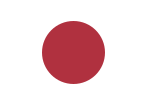 |
| Administration |
|
(Dai Nippon Teikoku Rikugun) |
|
(Dai Nippon Teikoku Kaigun) |
| Rank insignia |
| History |
- Naval history of Japan
- Imperial Japanese Navy Aviation Bureau
- Giretsu special forces operations
- Japanese Special Naval Landing Forces
- Imperial Japanese Navy Land Forces
- Imperial Japanese Navy Armor Units
- Tokei Tai-Navy Military Police
- Imperial Japanese Navy fuel
- List of Japanese Navy ships and warvessels in World War II
- "Strike South" Group
- Nanshin-ron Doctrine (Japanese Navy s conquest policy)
- Fleet Faction — Navy political group
- Treaty Faction — Navy political group
- May 15 Incident — coup d'etat with Navy support
- Imperial Way Faction
- Japanese nationalism
- The Japanese Navy Taiwan and South Pacific Mandate political project
- Imperial Rescript to Soldiers and Sailors
- Imperial Japanese Naval Academy
- Admiral of the Fleet (Japan)
- List of Japanese Navy officers (WWII)
Notes
- ^ Evans, Kaigun
- ^ THE FIRST IRONCLADS In Japanese: [1], [2]. Also in English: [3]: "Iron clad ships, however, were not new to Japan and Hideyoshi; Oda Nobunaga, in fact, had many iron clad ships in his fleet." (referring to the anteriority of Japanese ironclads (1578) to the Korean Turtle ships (1592)). In Western sources, Japanese ironclads are described in CR Boxer "The Christian Century in Japan 1549–1650", p122, quoting the account of the Italian Jesuit Organtino visiting Japan in 1578. Nobunaga's ironclad fleet is also described in "A History of Japan, 1334–1615", Georges Samson, p309 ISBN 0-8047-0525-9. Korea's "ironclad Turtle ships" were invented by Admiral Yi Sun-sin (1545–1598), and are first documented in 1592. Incidentally, Korea's iron plates only covered the roof (to prevent intrusion), and not the sides of their ships. The first Western ironclads date to 1859 with the French Gloire ("Steam, Steel and Shellfire").
- ^ Described in "Soie et Lumiere", in a parallel to the French Military Mission to Japan (1867-1868) for the Army.
- ^ "Togo Heihachiro", II
- ^ "Togo Heiachiro", I7
- ^ "Togo Heihachiro", II
- ^ "Togo Heihachiro", II
- ^ Howe, p281
- ^ Peattie & Evans, Kaigun, p17
- ^ "Her armament of twelve quick-firing guns was formidable for her size, and her 23-knot speed made her the fastest cruiser in the world"ibid.
- ^ Video footage of the Sino-Japanese war: Video (external link). Template:Multi-video start Template:Multi-video item Template:Multi-video end
- ^ Evans Kaigun, p60-61
- ^ Corbett Maritime Operations in the Russo-Japanese War, 2:333
- ^ Howe, p284
- ^ Howe, p268
- ^ Evans, Kaigun, p84
- ^ "Laid down before Dreadnought and intended to carry 12-inch guns, she should have been completed as the world's first all-big-gun battleship. However, there were not enough Armstrong 1904 pattern 12-inch guns available, and 10-inch guns|had to be substituted for all but four of the weapons. Thus it was that future all-big gun battleships were to be called "dreadnoughts", and not "satsumas"." Jane's "Battleships of the 20th century", p68
- ^ "when completed, the most formidable and most superbly designed capital ships in the world" Evans, Kaigun, p161
- ^ Evans, Kaigun, p212
- ^ Lyon World War II warships p34
- ^ Peattie & Evans, Kaigun.
- ^ Miller, Edward S. War Plan Orange. Annapolis, MD: United States Naval Institute Press, 1991.
- ^ Mahan, Alfred T. Influence of Seapower on History, 1660-1783. Boston: Little, Brown.
- ^ Miller, op. cit.
- ^ Peattie & Evans, op. cit., and Willmott, H. P.,The Barrier and the Javelin. Annapolis, MD: United States Naval Institute Press, 1983.
- ^ Lyon World War II warships p35
- ^ Howe, p286
- ^ Parillo, Mark. Japanese Merchant Marine in World War 2. Annapolis, MD: United States Naval Institute Press, 1993.
- ^ "In many ways the Japanese were in the forefront of carrier design, and in 1941, the two Shōkakus — the culmination of prewar Japanese design — were superior to any carrier in the world then in commission" Evans, Kaigun p323
- ^ "For speed and maneuverability, for example the Zero was matchless; for range and speed few bombers surpassed the Mitsubishi G3M, and in the Kawanishi H8K, the Japanese navy had the world's best flying boat" Evans, Kaigun, p312
- ^ "by 1941, by training and experience, Japan's naval aviators were undoubtedly the best among the world's three carrier forces" Evans, Kaigun, p325
- ^ Japanese submarines, p70
External links
- Nobunaga's ironclad navy
- Hiroshi Nishida's IJN site
- Imperial Japanese Navy Page
- Etajima Museum of Naval History
- JSDF video commercial
- Fading Victory: The Diary of Admiral Matome Ugaki, 1941-1945 - book review
- Imperial Japanese Navy Awards of the Golden Kite in World War 2, a Note
- Imperial Japanese Navy in World War 1, 1914-18 including warship losses
